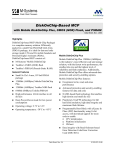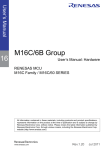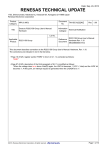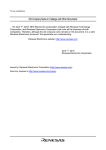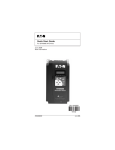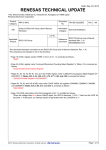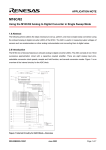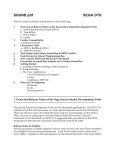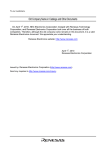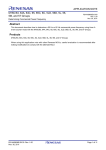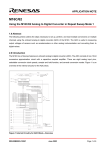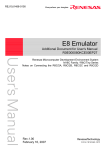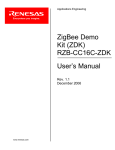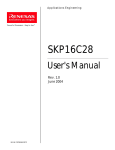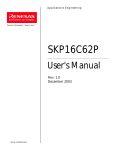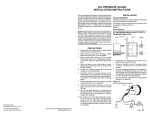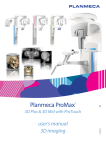Download Differences between M16C/62P and M16C/65C
Transcript
APPLICATION NOTE M16C/62P Group, M16C/65C Group Differences between M16C/62P and M16C/65C R01AN0443EJ0100 Rev. 1.00 Jul 29, 2011 Abstract The following document describes differences between M16C/62P 100-pin version and M16C/65C 100-pin version. Refer to each device's hardware manual for details. Products MCUs: M16C/62P Group, M16C/65C Group With its enhanced peripheral functions, the M16C/65C Group MCU has pin assignments and peripheral functions that are compatible with the M16C/62P Group, making it simple to replace the M16C/62P Group with the M16C/65C Group. R01AN0443EJ0100 Rev. 1.00 Jul 29, 2011 Page 1 of 31 M16C/62P Group, M16C/65C Group Differences between M16C/62P and M16C/65C Contents 1. Differences ................................................................................................................. 3 1.1 Differences in Functions ................................................................................................................. 3 1.2 Pin Characteristics .......................................................................................................................... 6 2. Detailed Comparison ................................................................................................. 7 2.1 Differences in Protection ................................................................................................................. 7 2.2 Differences in Reset ....................................................................................................................... 7 2.3 Differences in Voltage Detector ...................................................................................................... 8 2.4 Differences in Clock Generator ....................................................................................................... 9 2.5 Differences in Power Control ........................................................................................................ 10 2.6 Differences in Processor Mode ..................................................................................................... 10 2.7 Differences in Bus ..........................................................................................................................11 2.8 Differences in Programmable I/O Port .......................................................................................... 12 2.9 Differences in Interrupts ................................................................................................................ 13 2.10 Differences in Watchdog Timer ..................................................................................................... 16 2.11 Differences in DMAC .................................................................................................................... 17 2.12 Differences in Timers .................................................................................................................... 19 2.13 Differences in the Three-phase Motor Control Timer Function ..................................................... 22 2.14 Differences in Serial Interface ....................................................................................................... 23 2.15 Differences in A/D Converter ........................................................................................................ 26 2.16 Differences in CRC Calculator ...................................................................................................... 27 2.17 Differences in Flash Memory ........................................................................................................ 27 2.18 Differences in Flash Memory Block Configuration ........................................................................ 29 2.19 New Functions added in the M16C/65C ....................................................................................... 30 2.20 Differences in Development Tool .................................................................................................. 30 3. Reference Documents ............................................................................................. 31 R01AN0443EJ0100 Rev. 1.00 Jul 29, 2011 Page 2 of 31 Differences between M16C/62P and M16C/65C M16C/62P Group, M16C/65C Group 1. Differences 1.1 Differences in Functions Table 1.1 and Table 1.3 list Differences in Functions. Differences in Functions (1/3) (1) Table 1.1 Item M16C/62P M16C/65C Minimum Instruction Execution Time 41.7 ns (f(BCLK) = 24 MHz, VCC1 = 3.0 to 5.5 V) 31.25 ns (f(BLCK) = 32 MHz, VCC1 = 2.7 to 100 ns (f(BCLK) = 10 MHz, VCC1 = 2.7 to 5.5 V) 5.5 V) Clock Generator PLL, XIN, XCIN, on-chip oscillator (approx.1 MHz) PLL, XIN, XCIN, 125 kHz on-chip oscillator, 40 MHz on-chip oscillator Timer/peripheral clock stop function No Yes Slow read mode No Yes Low current consumption No read mode Yes Power Control CPU Clock After Reset NMI Pin Expanded area External Bus Main clock divided by 8 125 kHz on-chip oscillator clock divided by 8 NMI interrupt input port PM24 bit = 0 (when NMI is disabled): I/O port (N-channel open drain output) PM24 bit = 1 (when NMI is enabled): NMI interrupt input port 04000h to 07FFFh (when PM13 = 0) 08000h to 0CFFFh (when PM10 = 0) 04000h to 07FFFh (when PM13 = 0) 0D800h to 0DFFFh 08000h to 0FFFFh (when PM10 = 0) 0E000h to 0FFFFh (when PM10 = 0) 10000h to 26FFFh 10000h to 13FFFh (when PRG2C0 = 1) 28000h to 7FFFFh 14000h to 26FFFh 80000h to CFFFFh (when PM13 = 0) 28000h to 7FFFFh D0000h to FFFFFh (in microprocessor mode) 80000h to CFFFFh (when PM13 = 0) D0000h to FFFFFh (in microprocessor mode) HOLD input Enabled Disabled Bus wait 0 to 3 wait(s) selectable 0 to 8 wait(s) selectable Recovery cycle No 0 to 3 cycle(s) selectable External interrupts: 8 External interrupts: 13 Interrupt Reset start No Selectable from start and stop Watchdog function Timer Count source CPU clock, on-chip oscillator (approx. 1 MHz) CPU clock, on-chip oscillator (125 kHz) DMA DMAC 2 channels Trigger sources: 25 4 channels Trigger sources: 43 PM24: Bit in the PM2 register PM13, PM10: Bits in the PM1 register PRG2C0: Bit in the PRG2C register Note: 1. Refer to the User’s Manual: Hardware for electrical characteristics and more details. R01AN0443EJ0100 Rev. 1.00 Jul 29, 2011 Page 3 of 31 Differences between M16C/62P and M16C/65C M16C/62P Group, M16C/65C Group Table 1.2 Differences in Functions (2/3) (1) Item Timer A, timer B count source Timer Serial Interface A/D Converter CRC Calculator M16C/62P Selectable from f1, f2, f8, f32, and fC32 M16C/65C Selectable from f1TIMAB and f2TIMAB, f8TIMAB, f32TIMAB, f64TIMAB, fOCO-S, fOCO-F, and fC32 Real-time clock No Count: second, minute, hour, day of week PWM function No 8 bits x 2 Remote control signal receive function No 2 circuits UART Clock synchronous/asynchronous x 3 channels Clock synchronous/asynchronous x 6 channels UART0 to UART2, UART5 to UART7 clock prior to division select function f1 only Selectable from f1 and fOCO-F CEC No Yes Multi-master I2CNo bus interface 1 channel Resolution 8-bit/10-bit (selectable) 10-bit only Operation clock φAD Selectable from f1, f1 divided by 2, f1 divided by 3, f1 divided by 4, f1 divided by Selectable from fAD, fAD divided by 2, fAD 6, f1 divided by 12, fOCO40M divided by 2, divided by 3, fAD divided by 4, fAD divided fOCO40M divided by 3, fOCO40M divided by 6, and fAD divided by 12 by 4, fOCO40M divided by 6, and fOCO40M divided by 12 Sample and hold Yes/No (selectable) Yes Generator polynomial Selectable from CRC-CCITT (X16 + X12 + X5 + 1) and CRC-16 (X16 + X15 + X2 + 1) CRC-CCITT (X16 + X12 + X5 + 1) MSB/LSB select No function Yes CRC snoop Yes No Note: 1. Refer to the User’s Manual: Hardware for electrical characteristics and more details. R01AN0443EJ0100 Rev. 1.00 Jul 29, 2011 Page 4 of 31 Differences between M16C/62P and M16C/65C M16C/62P Group, M16C/65C Group Table 1.3 Differences in Functions (3/3) (1) Item M16C/62P Address FFFFFh ROM code protect select function function setting Flash Memory M16C/65C Selectable Options • Watchdog timer autostart function (after reset) • Count source protection mode select function (after reset) • ROM code protect function • Vdet0 select function • Voltage monitor 0 reset function (after hardware reset) Memory map User ROM Program ROM 080000h to 0FFFFFh Data flash Block A 00F000h to 00FFFFh User ROM • Program ROM 1 080000h to 0FFFFFh • Program ROM 2 010000h to 013FFFh Data flash • Block A 00E000h to 00EFFFh • Block B 00F000h to 00FFFFh User ROM (512-Kbyte) 64 KB x 7 32 KB x 1 8 KB x 3 4 KB x 2 64 KB x 8 16 KB x 1 (program ROM 2) Data flash 4 KB x 1 (block A) 4 KB x 2 (block A, block B) Program method In units of 1 word (16-bit) In units of 2 words (32-bit) Erase method Erase all unlocked blocks, block erase Block erase User boot mode No Yes Note: 1. Refer to the User’s Manual: Hardware for electrical characteristics and more details. R01AN0443EJ0100 Rev. 1.00 Jul 29, 2011 Page 5 of 31 Differences between M16C/62P and M16C/65C M16C/62P Group, M16C/65C Group 1.2 Pin Characteristics Table 1.4 lists Differences in Pin Characteristics. Table 1.4 Differences in Pin Characteristics M16C/62P M16C/65C Changes from M16C/62P P9_4 / TB4IN / DA1 P9_4 / TB4IN / DA1 / PWM1 Added: PWM1 P9_3 / TB3IN / DA0 P9_3 / TB3IN / DA0 / PWM0 Added: PWM0 P9_2 / TB2IN / SOUT3 P9_2 / TB2IN / SOUT3 / PMC0 Added: PMC0 P9_1 / TB1IN / SIN3 P9_1 / TB1IN / SIN3 / PMC1 Added: PMC1 P8_5 / NMI P8_5 / NMI / SD / CEC Added: SD/CEC P8_1 / TA4IN / U P8_1 / TA4IN / U / CTS5 / RTS5 Added: CTS5 / RTS5 P8_0 / TA4OUT / U P8_0 / TA4OUT / U / RXD5 / SCL5 Added: RXD5/SCL5 P7_7 / TA3IN P7_7 / TA3IN / CLK5 Added: CLK5 P7_6 / TA3OUT P7_6 / TA3OUT / TXD5 / SDA5 Added: TXD5/SDA5 P7_1 / TA0IN / TB5IN / RXD2 / SCL2 P7_1 / TA0IN / TB5IN / RXD2 / SCL2 / SCLMM Added: SCLMM P7_0 / TA0OUT / TXD2 / SDA2 P7_0 / TA0OUT / TXD2 / SDA2 / SDAMM Added: SDAMM P6_0 / CTS0 / RTS0 P6_0 / CTS0 / RTS0 / RTCOUT Added: RTCOUT P4_7 / CS3 P4_7 / CS3 / PWM1 / TXD7 / SDA7 Added: PWM1/TXD7/SDA7 P4_6 / CS2 P4_6 / CS2 / PWM0 / RXD7 / SCL7 Added: PWM0/RXD7/SCL7 P4_5 / CS1 P4_5 / CS1 / CLK7 Added: CLK7 P4_4 / CS0 P4_4 / CS0 / CTS7 / RTS7 Added: CTS7 / RTS7 P2_5 / AN2_5 / A5 (/ D5 / D4) P2_5 / INT7 / AN2_5 / A5, [A5 / D5], [A5 / D4] Added: INT7 P2_4 / AN2_4 / A4 (/ D4 / D3) P2_4 / INT6 / AN2_4 / A4, [A4 / D4], [A4 / D3] Added: INT6 P1_7 / INT5 / D15 P1_7 / INT5 / D15 / IDU Added: IDU P1_6 / INT4 / D14 P1_6 / INT4 / D14 / IDW Added: IDW P1_5 / INT3 / D13 P1_5 / INT3 / D13 / IDV Added: IDV P1_3 / D11 P1_3 / D11 / TXD6 / SDA6 Added: TXD6 / SDA6 P1_2 / D10 P1_2 / D10 / RXD6 / SCL6 Added: RXD6 / SCL6 P1_1 / D9 P1_1 / D9 / CLK6 Added: CLK6 P1_0 / D8 P1_0 / D8 / CTS6 / RTS6 Added: CTS6 / RTS6 R01AN0443EJ0100 Rev. 1.00 Jul 29, 2011 Page 6 of 31 Differences between M16C/62P and M16C/65C M16C/62P Group, M16C/65C Group 2. Detailed Comparison 2.1 Differences in Protection Table 2.1 lists Differences in Registers Associated with the Protect Function. Table 2.1 Symbol Differences in Registers Associated with the Protect Function Address M16C/62P PRCR 2.2 M16C/65C 000Ah Differences Bit 000Ah M16C/62P M16C/65C 0 Protect bit 0 Enable write access to registers CM0, CM1, CM2, PLC0, and PCLKR Protect bit 0 Enable write access to registers CM0, CM1, CM2, PLC0, PCLKR, and FRA0 3 Protect bit 3 Enable write access to registers VCR2, and D4INT Protect bit 3 Enable write access to registers VCR2, VWCE, VD1LS, VW0C, VW1C, and VW2C 6 — Protect bit 6 Enable write access to the PRG2C register Differences in Reset Table 2.2 lists Differences in Reset and Table 2.3 lists Difference in the Register Associated with Reset. Table 2.2 Differences in Reset Item M16C/62P M16C/65C Types of resets Hardware reset Brown-out detection reset Oscillation stop detection reset Watchdog timer reset Software reset Hardware reset Voltage monitor 0 reset Voltage monitor 1 reset Voltage monitor 2 reset Power-on reset Oscillation stop detection reset Watchdog timer reset Software reset Cold start, warm start discrimination method WDC5 bit in the WDC register CWR bit in the RSTFR register Reset Source Determine Register No Yes Table 2.3 Symbol RSTFR Difference in the Register Associated with Reset Address M16C/62P M16C/65C — 0018h R01AN0443EJ0100 Rev. 1.00 Jul 29, 2011 Differences Bit — M16C/62P — M16C/65C M16C/65C only Page 7 of 31 Differences between M16C/62P and M16C/65C M16C/62P Group, M16C/65C Group 2.3 Differences in Voltage Detector Table 2.4 lists Differences in Voltage Detector and Table 2.5 lists Differences in Registers Associated with Voltage Detector. Table 2.4 Differences in Voltage Detector Item M16C/62P Voltage detection interrupt monitor level M16C/65C Vdet4 • Vdet1 (voltage detection circuit 1) • Vdet2 (voltage detection circuit 2) Voltage detection reset Vdet3 monitor level • Vdet0 (voltage detection circuit 0) • Vdet1 (voltage detection circuit 1) • Vdet2 (voltage detection circuit 2) Refer to the Electric Characteristics chapter in the User’s Manual: Hardware for detection voltage. Table 2.5 Symbol VCR2 Differences in Registers Associated with Voltage Detector Address M16C/62P 001Ah M16C/65C 001Ah Differences Bit M16C/62P M16C/65C 5 Reserved bit Voltage detector 0 enable bit 0: Voltage detector 0 disabled 1: Voltage detector 0 enabled 6 Reset Level Monitor Bit 0 : Disable reset level detection circuit 1 : Enable reset level detection circuit Voltage detector 1 enable bit 0: Voltage detector 1 disabled 1: Voltage detector 1 enabled 7 Low Voltage Monitor Bit 0 : Disable low voltage detection circuit 1 : Enable low voltage detection circuit Voltage detector 2 enable bit 0: Voltage detector 2 disabled 1: Voltage detector 2 enabled D4INT 001Fh — — M16C/62P only — VWCE — 0026h — — M16C/65C only VD1LS — 0028h — — M16C/65C only VW0C — 002Ah — — M16C/65C only VW1C — 002Bh — — M16C/65C only VW2C — 002Ch — — M16C/65C only R01AN0443EJ0100 Rev. 1.00 Jul 29, 2011 Page 8 of 31 Differences between M16C/62P and M16C/65C M16C/62P Group, M16C/65C Group 2.4 Differences in Clock Generator Table 2.6 lists Differences in Clock Generator and Table 2.7 and Table 2.8 list Differences in Registers Associated with Clock Generator (1/2). Table 2.6 Differences in Clock Generator Item M16C/62P M16C/65C Clock output function Selectable from fC, f8, and f32 Selectable from fC, f8, f32, and f1 CPU clock after reset Main clock divided by 8 (default setting of the CM21 bit: 0) 125 kHz on-chip oscillator clock divided by 8 (default setting of CM21 bit: 1) Peripheral clock (fC) Provided constantly Selectable whether fC is provided or not by setting the PM25 bit in the PM2 register. 40 MHz on-chip oscillator No Yes 125 kHz on-chip oscillator No Yes On-chip oscillator frequency Approx. 1 MHz Approx. 125 kHz, approx. 40 MHz Calculation formula for PLL clock frequency f(XIN) x n f(XIN)/m x n Timer/peripheral clock stop function No Yes CM21: Bit in the CM1 register n: Multiply ratio set by bits PLC02 to PLC00 in the PLC0 register m: Division ratio set by bits PLC05 to PLC04 in the PLC0 register Table 2.7 Symbol Differences in Registers Associated with Clock Generator (1/2) Address Bit M16C/62P M16C/65C Differences M16C/62P 3 CM1 0007h 0007h Reserved bits 4 — PCLKR 025Eh 0012h PCLKSTP1 — 0016h PLC0 001Ch 001Ch 5 Reserved bit — — Reserved bit 4 Set to 1. 5 Reserved bit R01AN0443EJ0100 Rev. 1.00 Jul 29, 2011 M16C/65C XIN-XOUT feedback resistor select bit 0 : Internal feedback resistor connected 1 : Internal feedback resistor not connected 125 kHz on-chip oscillator stop bit 0: 125 kHz on-chip oscillator on 1: 125 kHz on-chip oscillator off Different addresses Clock output function extension bit (enabled in single-chip mode) 0: Selected by setting bits CM01 to CM00 in the CM0 register 1: Output f1 M16C/65C only Reference frequency counter set bit 00: No division 01: Divide-by-2 10: Divide-by-4 11: Do not set Page 9 of 31 Differences between M16C/62P and M16C/65C M16C/62P Group, M16C/65C Group Table 2.8 Differences in Registers Associated with Clock Generator (2/2) Address Bit M16C/62P M16C/65C Symbol 0 2 PM2 001Eh 001Eh 4 5 FRA0 2.5 — 0022h — Differences M16C/62P M16C/65C Specifying wait when accessing SFR at PLL operation Reserved bit 0 : 2 waits Set to 1. 1 : 1 wait WDT count source protect bit 0: CPU clock is used for the watchdog timer count source No register bit 1: On-chip oscillator clock is used for the watchdog timer count source NMI interrupt enable bit 0: NMI interrupt disabled Reserved bit 1: NMI interrupt enabled Peripheral clock fC provide bit No register bit 0: Not provided 1: Provided — M16C/65C only Differences in Power Control Table 2.9 lists Differences in Power Control and Table 2.10 lists Difference in the Register Associated with Power Control. Table 2.9 Differences in Power Control Item M16C/62P M16C/65C Slow read mode No Yes Low current consumption read mode No Yes Table 2.10 Difference in the Register Associated with Power Control Address Symbol M16C/62P M16C/65C — 0222h FMR2 2.6 Differences Bit — M16C/62P M16C/65C — M16C/65C only Differences in Processor Mode Table 2.11 lists Differences in Registers Associated with Processor Mode. Table 2.11 Symbol Differences in Registers Associated with Processor Mode Address M16C/62P M16C/65C Differences Bit M16C/62P PM1 0005h 0005h 0 CS2 area switch bit 0: 08000h to 26FFFh (block A disabled) 1: 10000h to 26FFFh (block A enabled) PRG2C — 0010h — — R01AN0443EJ0100 Rev. 1.00 Jul 29, 2011 M16C/65C CS2 area switch bit 0: CS2 area (0E000h to 0FFFFh) 1: Data flash (0E000h to 0FFFFh) M16C/65C only Page 10 of 31 Differences between M16C/62P and M16C/65C M16C/62P Group, M16C/65C Group 2.7 Differences in Bus Table 2.12 lists Differences in Bus and Table 2.13 lists Differences in Registers Associated with Bus. Table 2.12 Differences in Bus Item M16C/62P M16C/65C External area wait Selectable from 0 to 3 wait(s) CSiW bit in the CSR register, Selected by bits CSEi0W and CSEi1W in the CSE register (i = 0 to 3) Selectable from 0 to 8 wait(s) Selected by CSiW bit in the CSR register, bits CSEi0W and CSEi1W in the CSE register, and bits EWCi0 to EWCi1 in the EWC register Recovery cycle No Selectable from 0 to 3 cycle(s) Selectable by bits EWR0 to EWR1 in the EWR register Table 2.13 Symbol Differences in Registers Associated with Bus Address M16C/62P M16C/65C Differences Bit M16C/62P M16C/65C CS0 wait expansion bit 1-0 CS0 wait expansion bit b1 b0 b1 b0 1 1: Select wait states by bits EWC01 and EWC00 in the EWC register 1 1: Do not set CS1 wait expansion bit 3 -2 CS1 wait expansion bit b3 b2 b3 b2 1 1: Select wait states by bits EWC11 and EWC10 in the EWC register 1 1: Do not set CSE 001Bh 001Bh CS2 wait expansion bit 5-4 CS2 wait expansion bit b5 b4 b5 b4 1 1: Select wait states by bits EWC21 and EWC20 in the EWC register 1 1: Do not set CS3 wait expansion bit 7-6 CS3 wait expansion bit b7 b6 b7 b6 1 1: Do not set 1 1: Select wait states by bits EWC31 and EWC30 in the EWC register EWC — 0011h — — M16C/65C only EWR — 0009h — — M16C/65C only R01AN0443EJ0100 Rev. 1.00 Jul 29, 2011 Page 11 of 31 Differences between M16C/62P and M16C/65C M16C/62P Group, M16C/65C Group 2.8 Differences in Programmable I/O Port Table 2.14 lists Difference in Programmable I/O Port and Table 2.15 lists Differences in Registers Associated with Programmable I/O Port. Table 2.14 Difference in Programmable I/O Port Item M16C/62P NMI / SD digital filter Table 2.15 Symbol M16C/65C Selectable whether the digital filter is used or not with the NMIDF register No Differences in Registers Associated with Programmable I/O Port Address M16C/62P M16C/65C Differences Bit M16C/62P Port P8_5 direction bit 0 : Input mode (Functions as an input port) 1 : Output mode (Functions as an output port) PD8 03F2h 03F2h 5 PUR0 03FCh 0360h — Different addresses PUR1 03FDh 0361h — Different addresses PUR2 03FEh 0362h — Different addresses — Different addresses PCR NMIDF 03FFh — R01AN0443EJ0100 Rev. 1.00 Jul 29, 2011 0366h 0369h No register bit M16C/65C 3 No register bit Reserved bit 4 No register bit CEC output enable bit 5 No register bit INT6 input enable bit 6 No register bit INT7 input enable bit 7 No register bit Key input enable bit — — M16C/65C only Page 12 of 31 Differences between M16C/62P and M16C/65C M16C/62P Group, M16C/65C Group 2.9 Differences in Interrupts Table 2.16 lists Difference in Interrupts, and Table 2.17 to Table 2.18 list Differences in Interrupt Vectors, and Table 2.19 lists Differences in Registers Associated with Interrupts. Table 2.16 Difference in Interrupts Item M16C/62P NMI enable function Table 2.17 Software Interrupt Number M16C/65C Selectable whether to enable or disable the function with the PM24 bit in the PM2 register Enable only Differences in Interrupt Vectors (1/2) Vector Address M16C/62P 0 +0 to +3 (0000h to 0003h) 1 +4 to +7 (0004h to 0007h) 2 +8 to +11 (0008h to 000Bh) 3 +12 to +15 (000Ch to 000Fh) 4 +16 to +19 (0010h to 0013h) INT3 INT3 5 +20 to +23 (0014h to 0017h) Timer B5 Timer B5 6 +24 to +27 (0018h to 001Bh) Timer B4, UART1 start/stop condition detection, bus collision detection Timer B4, UART1 start/stop condition detection, bus collision detection 7 +28 to +31 (001Ch to 001Fh) Timer B3, UART0 start/stop condition detection, bus collision detection Timer B3, UART0 start/stop condition detection, bus collision detection 8 +32 to +35 (0020h to 0023h) SI/O4, INT5 SI/O4, INT5 9 +36 to +39 (0024h to 0027h) SI/O3, INT4 SI/O3, INT4 10 +40 to +43 (0028h to 002Bh) UART2 start/stop condition detection, bus collision detection UART2 start/stop condition detection, bus collision detection 11 +44 to +47 (002Ch to 002Fh) DMA0 DMA0 12 +48 to +51 (0030h to 0033h) DMA1 DMA1 13 +52 to +55 (0034h to 0037h) Key input interrupt Key input interrupt 14 +56 to +59 (0038h to 003Bh) A/D converter A/D converter 15 +60 to +63 (003Ch to 003Fh) UART2 transmit, NACK2 UART2 transmit, NACK2 16 +64 to +67 (0040h to 0043h) UART2 receive, ACK2 UART2 receive, ACK2 17 +68 to +71 (0044h to 0047h) UART0 transmit, NACK0 UART0 transmit, NACK0 18 +72 to +75 (0048h to 004Bh) UART0 receive, ACK0 UART0 receive, ACK0 19 +76 to +79 (004Ch to 004Fh) UART1 transmit, NACK1 UART1 transmit, NACK1 20 +80 to +83 (0050h to 0053h) UART1 receive, ACK1 UART1 receive, ACK1 21 +84 to +87 (0054h to 0057h) Timer A0 Timer A0 22 +88 to +91 (0058h to 005Bh) Timer A1 Timer A1 23 +92 to +95 (005Ch to 005Fh) Timer A2 Timer A2 24 +96 to +99 (0060h to 0063h) Timer A3 Timer A3 25 +100 to +103 (0064h to 0067h) Timer A4 Timer A4 26 +104 to +107 (0068h to 006Bh) Timer B0 Timer B0 27 +108 to +111 (006Ch to 006Fh) Timer B1 Timer B1 28 +112 to +115 (0070h to 0073h) Timer B2 Timer B2 R01AN0443EJ0100 Rev. 1.00 Jul 29, 2011 BRK instruction M16C/65C BRK instruction INT instruction interrupt — (Reserved) INT7 INT6 Page 13 of 31 Differences between M16C/62P and M16C/65C M16C/62P Group, M16C/65C Group Table 2.18 Differences in Interrupt Vectors (2/2) Software Interrupt Number Vector Address M16C/62P 29 +116 to +119 (0074h to 0077h) INT0 INT0 30 +120 to +123 (0078h to 007Bh) INT1 INT1 31 +124 to +127 (007Ch to 007Fh) INT2 INT2 32 to 40 +128 to +131 (0080h to 0083h) to +160 to +163 (00A0h to 00A3h) INT instruction interrupt 41 +164 to +167 (00A4h to 00A7h) DMA2 42 +168 to +171 (00A8h to 00ABh) DMA3 43 +172 to +175 (00ACh to 00AFh) UART5 start/stop condition detection, bus collision detection, CEC1 44 +176 to +179 (00B0h to 00B3h) UART5 transmit, NACK5, CEC2 45 +180 to +183 (00B4h to 00B7h) UART5 receive, ACK5 46 +184 to +187 (00B8h to 00BBh) UART6 start/stop condition detection, bus collision detection, real-time clock period 47 +188 to +191 (00BCh to 00BFh) UART6 transmit, NACK6, real-time clock compare 48 +192 to +195 (00C0h to 00C3h) UART6 receive, ACK6 49 +196 to +199 (00C4h to 00C7h) UART7 start/stop condition detection, bus collision detection, remote control 0 50 +200 to +203 (00C8h to 00CBh) UART7 transmit, NACK7, remote control 1 51 +204 to +207 (00CCh to 00CFh) UART7 receive, ACK7 52 to 58 +208 to +211 (00D0h to 00D3h) to +232 to +235 (00E8h to 00EBh) INT instruction interrupt 59 +236 to +239 (00ECh to 00EFh) I2C-bus interface interrupt 60 +240 to +243 (00F0h to 00F3h) SCL/SDA interrupt 61 to 63 +244 to +247 (00F4h to 00F7h) to +252 to +255 (00FCh to 00FFh) INT instruction interrupt INT instruction interrupt R01AN0443EJ0100 Rev. 1.00 Jul 29, 2011 M16C/65C Page 14 of 31 Differences between M16C/62P and M16C/65C M16C/62P Group, M16C/65C Group Table 2.19 Symbol IFSR3A Differences in Registers Associated with Interrupts Address M16C/62P M16C/65C — 0205h — — Different addresses 3 4 035Eh M16C/62P — 2 IFSR2A Differences Bit M16C/65C M16C/65C only No register bit Interrupt request source select bit 0: Not used 1: I2C-bus interface No register bit Interrupt request source select bit 0: Not used 1: SCL/SDA No register bit Interrupt request source select bit 0: UART7 start/stop condition detection, bus collision detection 1: Remote control receiving function 0 No register bit Interrupt request source select bit 0: UART7 transmission, NACK 1: Remote control receiving function 1 0206h 5 6 7 Interrupt request factor select bit 0: Timer B3 1: UART0 bus collision detection Interrupt request factor select bit 0: Timer B4 1: UART1 bus collision detection Interrupt request source select bit 0: Timer B3 1: UART0 start/stop condition detection, bus collision detection Interrupt request source select bit 0: Timer B4 1: UART1 start/stop condition detection, bus collision detection IFSR 035Fh 0207h — Different addresses AIER 0009h 020Eh — Different addresses AIER2 01BBh 020Fh — Different addresses RMAD0 0010h to 0012h 0210h to 0212h — Different addresses RMAD1 0014h to 0016h 0214h to 0216h — Different addresses RMAD2 01B8h to 01BAh 0218h to 021Ah — Different addresses RMAD3 01BCh to 01BEh 021Ch to 021Eh — Different addresses R01AN0443EJ0100 Rev. 1.00 Jul 29, 2011 Page 15 of 31 Differences between M16C/62P and M16C/65C M16C/62P Group, M16C/65C Group 2.10 Differences in Watchdog Timer Table 2.20 lists Differences in Watchdog Timer and Table 2.21 lists Differences in Registers Associated with Watchdog Timer. Table 2.20 Differences in Watchdog Timer Item M16C/62P M16C/65C Count source protect mode enable setting Set the PM22 bit in the PM2 register to 1. Set the CSPRO bit in the CSPR register to 1.(1) Watchdog timer cycle in count source protection mode Approx. 32.8 ms (32768 / approx. 1 MHz) Approx. 32.8 ms (4096 / approx. 125 kHz) Watchdog timer counter refresh Write 00h, and then FFh to the WDTR register Count start conditions Watchdog timer counter is initialized and starts •Count automatically starts after reset by counting by writing to the WDTS register. setting the WDTON bit in the OFS1 address to 0. •Count starts by writing to the WDTS register. Note: 1. When the CSPROINI bit in the OFS1 address is 0, the value after reset becomes 1. Table 2.21 Symbol WDTS Differences in Registers Associated with Watchdog Timer Address M16C/62P M16C/65C 000Eh 037Eh Differences Bit M16C/62P — M16C/65C Different addresses — Different addresses 5 Cold Start / Warm Start Discrimination Flag 0 : Cold Start 1 : Warm Start No register bit WDC 000Fh 037Fh VW2C — 002Ch — — M16C/65C only CSPR — 037Ch — — M16C/65C only WDTR — 037Dh — — M16C/65C only R01AN0443EJ0100 Rev. 1.00 Jul 29, 2011 Page 16 of 31 Differences between M16C/62P and M16C/65C M16C/62P Group, M16C/65C Group 2.11 Differences in DMAC Table 2.22 lists Difference in DMAC, Table 2.23 to Table 2.24 list Differences in DMA Request Sources, and Table 2.25 lists Differences in Registers Associated with DMAC. Table 2.22 Difference in DMAC Item M16C/62P Number of channels Table 2.23 M16C/65C 4 channels Differences in DMAi Request Sources (i = 0 and 1 in M16C/62P; i = 0 to 3 in M16C/65C) (1/2) M16C/62P DSEL4 to DSEL0 00000b 2 channels DMS = 0 M16C/65C DMS = 1 DMS = 0 DMS = 1 Falling edge of INTi pin — Falling edge of INTi pin 00001b Software trigger — Software trigger — 00010b Timer A0 — Timer A0 — — 00011b Timer A1 — Timer A1 — 00100b Timer A2 — Timer A2 — 00101b Timer A3 SI/O3 (DMA1 only) Timer A3 SI/O3 (DMA1, DMA3 only) Timer A4 DMA0: Both edges of INTi pin Timer A4 DMA1: SI/O4 DMA0, DMA2: Both edges of INTi pin DMA1, DMA3: SI/O4 00111b Timer B0 DMA0, DMA2: Timer B3 Timer B0 DMA1, DMA3: Both edges of INTi pin DMA0, DMA2: Timer B3 DMA1,DMA3: Both edges of INTi pin 01000b Timer B1 Timer B4 (DMA0 only) Timer B1 Timer B4 (DMA0, DMA2 only) 01001b Timer B2 Timer B5 (DMA0 only) Timer B2 Timer B5 (DMA0, DMA2 only) 01010b UART0 transmission — UART0 transmission — 01011b DMA0: UART0 reception DMA1: UART0 reception / ACK0 — DMA0, DMA2: UART0 reception DMA1, DMA3: UART0 reception / ACK0 — 01100b UART2 transmission — UART2 transmission — 01101b DMA0: UART2 reception DMA1: UART2 reception / ACK2 — DMA0, DMA2: UART2 reception DMA1, DMA3: UART2 reception / ACK2 — 01110b A/D converter — A/D converter — 01111b DMA0: UART1 transmission DMA1: UART1 reception / ACK1 — DMA0, DMA2: UART1 transmission DMA1, DMA3: UART1 reception / ACK1 — 00110b R01AN0443EJ0100 Rev. 1.00 Jul 29, 2011 Page 17 of 31 Differences between M16C/62P and M16C/65C M16C/62P Group, M16C/65C Group Table 2.24 DSEL4 to DSEL0 Differences in DMAi Request Sources (i = 0 and 1 in M16C/62P; i = 0 to 3 in M16C/65C) (2/2) M16C/62P DMS = 0 M16C/65C DMS = 1 DMS = 0 DMS = 1 DMA0, DMA2: UART1 reception DMA1, DMA3: UART1 transmission Falling edge of INTj pin (j = 4 to 7) 10001b UART5 transmission Both edges of INTj pin 10010b DMA0, DMA2: UART5 reception — DMA1, DMA3: UART5 reception / ACK5 10000b 10011b UART6 transmission 10100b DMA0, DMA2: UART6 reception — DMA1, DMA3: UART6 reception / ACK6 10101b UART7 transmission 10110b DMA0, DMA2: UART7 reception — DMA1, DMA3: UART7 reception / ACK7 Table 2.25 Symbol — — Differences in Registers Associated with DMAC Address Differences Bits M16C/62P M16C/65C M16C/62P M16C/65C DAR0 0024h to 0026h 0184h to 0186h — Different addresses DAR1 0034h to 0036h 0194h to 0196h — Different addresses DAR2 — 01A4h to 01A6h — — M16C/65C only DAR3 — 01B4h to 01B6h — — M16C/65C only DM0CON 002Ch 018Ch — Different addresses DM1CON 003Ch 019Ch — Different addresses DM2CON — 01ACh — — M16C/65C only DM3CON — 01BCh — — M16C/65C only SAR0 0020h to 0022h 0180h to 0182h — Different addresses SAR1 0030h to 0032h 0190h to 0192h — Different addresses SAR2 — 01A0h to 01A2h — — M16C/65C only SAR3 — 01B0h to 01B2h — — M16C/65C only TCR0 0028h to 0029h 0188h to 0189h — Different addresses TCR1 0038h to 0039h 0198h to 0199h — Different addresses TCR2 — 01A8h to 01A9h — — M16C/65C only TCR3 — 01B8h to 01B9h — — M16C/65C only DM0SL 03B8h 0398h — Different addresses DM1SL 03BAh 039Ah — Different addresses DM2SL — 0390h — — M16C/65C only DM3SL — 0392h — — M16C/65C only R01AN0443EJ0100 Rev. 1.00 Jul 29, 2011 Page 18 of 31 Differences between M16C/62P and M16C/65C M16C/62P Group, M16C/65C Group 2.12 Differences in Timers Table 2.26 lists Differences in Timers, and Table 2.27 to Table 2.28 list Differences in Registers Associated with Timers. Table 2.26 Differences in Timers Item M16C/62P M16C/65C Count source f1, f2, f8, f32, fC32 f1TIMAB, f2TIMAB, f8TIMAB, f32TIMAB, f64TIMAB, fOCO-S, fOCO-F, fC32 Timer clock source selection No (always f1) f1, selectable from main clock Timer peripheral clock stop function No Yes Clock select prior to timer AB division No Selectable from f1 and fOCO-F Output polarity inversion function No Yes Programmable output mode No Yes Count direction (up/down) selected by the TAiOUT pin (i = 0 to 4) Yes No Default value in pulse period/pulse width measurement modes Undefined Programmable When bits PPWFSk2 to PPWFSk0 in the PPWFSk register (k = 1 and 2) are 0: • Contents of the reload register (measurement result) can be read by reading the TBj register. Read from timer register in pulse period/pulse width measurement modes Contents of the reload register (measurement When bits PPWFSk2 to PPWFSk0 in the result) can be read by reading the TBj register PPWFSk register are 1: (j = 0 to 5). • Contents of the counter (current counter value) can be read by reading the TBj register • Contents of the reload register (measurement result) can be read by reading the TBj1 register Write to timer register in pulse period/pulse width measurement modes The value written to the TBj register is not written to neither the reload register nor the counter. Overflow flag clear method Wait one or more count source cycles after the MR3 bit becomes 1 (overflow) while the TBjS Write a value to the TBjMR register bit is 1 (start counting), then write a value to the TBjMR register. R01AN0443EJ0100 Rev. 1.00 Jul 29, 2011 When a value is written to the TBj register while the counter stops, the value is written to both the reload register and the counter. Page 19 of 31 Differences between M16C/62P and M16C/65C M16C/62P Group, M16C/65C Group Table 2.27 Symbol Differences in Registers Associated with Timers (1/2) Address M16C/62P M16C/65C Differences Bits M16C/62P 2-0 — — TAi count source select bit (i = 0, 2, and 4) Select the TAi count source — TAi count source option specify bit 0: TCK0 and TCK1 enabled, TCS0 to TCS2 disabled 1: TCK0 and TCK1 disabled, TCS0 to TCS2 enabled 6-4 — TAj count source select bit (j = 1 and 3) Select the TAj count source 3 TACS0 to TACS2 M16C/65C 01D0h to 01D2h 7 — — TAj count source option specify bit 0: TCK0 and TCK1 enabled, TCS4 to TCS6 disabled 1: TCK0 and TCK1 disabled, TCS4 to TCS6 enabled Different addresses TA0MR to TA4MR 0396h to 039Ah 0336h to 033Ah TA0 0386h to 0387h 0326h to 0327h — Different addresses TA1 0388h to 0389h 0328h to 0329h — Different addresses TA2 038Ah to 038Bh 032Ah to 032Bh — Different addresses TA3 038Ch to 038Dh 032Ch to 032Dh — Different addresses TA4 038Eh to 038Fh 032Eh to 032Fh — Different addresses TABSR 0380h 0320h — Different addresses UDF 0384h 0324h — Different addresses 4 Up/Down switching factor select bit 0: UDF register — 1: Input signal to TAiOUT pin ONSF 0382h 0322h — Different addresses TRGSR 0383h 0323h — Different addresses CPSRF 0381h 0015h — PCLKSTP1 — 0016h — — M16C/65C only TCKDIVC0 — 01CBh — — M16C/65C only PWMFS — 01D4h — — M16C/65C only TAPOFS — 01D5h — — M16C/65C only TAOW — 01D8h — — M16C/65C only TA11 0342h to 0343h 0302h to 0303h — TA21 0344h to 0345h 0304h to 0305h — TA41 0346h to 0347h 0306h to 0307h — R01AN0443EJ0100 Rev. 1.00 Jul 29, 2011 — — — Different addresses Different addresses — Used in programmable output mode Different addresses — Used in programmable output mode Different addresses — Used in programmable output mode Page 20 of 31 Differences between M16C/62P and M16C/65C M16C/62P Group, M16C/65C Group Table 2.28 Symbol Differences in Registers Associated with Timers (2/2) Address M16C/62P M16C/65C Differences Bit M16C/62P 2-0 — 3 TBCS0 TBCS1 TBCS2 TBCS3 01C8h 01C9h 01E8h 01E9h — — 6-4 — 7 — M16C/65C TBi count source select bit (i = 0, 2, 3, and 5) Select the TBi count source TBi count source option specify bit 0: TCK0 and TCK1 enabled, TCS0 to TCS2 disabled 1: TCK0 and TCK1 disabled, TCS0 to TCS2 enabled TBj count source select bit (j = 1 and 4) Select the TBj count source TBj count source option specify bit 0: TCK0 and TCK1 enabled, TCS4 to TCS6 disabled 1: TCK0 and TCK1 disabled, TCS4 to TCS6 enabled TB0MR to TB2MR 039Bh to 039Dh 033Bh to 033Dh — Different addresses TB3MR to TB5MR 035Bh to 035Dh 031Bh to 031Dh — Different addresses TB0 0390h to 0391h 0330h to 0331h — Different addresses TB1 0392h to 0393h 0332h to 0333h — Different addresses TB2 0394h to 0395h 0334h to 0335h — Different addresses TB3 0350h to 0351h 0310h to 0311h — Different addresses TB4 0352h to 0353h 0312h to 0313h — Different addresses TB5 0354h to 0355h 0314h to 0315h TBSR 0340h 0300h — Different addresses — Different addresses TABSR 0380h 0320h — PPWFS1 — 01C6h — — Different addresses M16C/65C only PPWFS2 — 01E6h — — M16C/65C only TB01 — 01C0h to 01C1h — — M16C/65C only TB11 — 01C2h to 01C3h — — M16C/65C only TB21 — 01C4h to 01C5h — — M16C/65C only TB31 — 01E0h to 01E1h — — M16C/65C only TB41 — 01E2h to 01E3h — — M16C/65C only TB51 — 01E4h to 01E5h — — M16C/65C only R01AN0443EJ0100 Rev. 1.00 Jul 29, 2011 Page 21 of 31 Differences between M16C/62P and M16C/65C M16C/62P Group, M16C/65C Group 2.13 Differences in the Three-phase Motor Control Timer Function Table 2.29 lists Differences in the Three-phase Motor Control Timer Function and Table 2.30 lists Differences in Registers Associated with the Three-phase Motor Control Timer Function. Table 2.29 Differences in the Three-phase Motor Control Timer Function Item M16C/62P M16C/65C Count source f1, f2, f8, f32, fC32 f1TIMAB, f2TIMAB, f8TIMAB, f32TIMAB, f64TIMAB, fOCO-S, fOCO-F, fC32 Position data retain function No Yes Three-phase PWM output pin select function No Yes Table 2.30 Symbol Differences in Registers Associated with the Three-phase Motor Control Timer Function Address Differences Bit M16C/62P M16C/65C DTT 034Ch 030Ch ICTB2 034Dh 030Dh — Different addresses IDB0 034Ah 030Ah — Different addresses IDB1 034Bh 030Bh — Different addresses INVC0 0348h 0308h — Different addresses 0349h 0309h INVC1 M16C/62P — M16C/65C Different addresses — Different addresses TA1 0388h to 0389h 0328h to 0329h — Different addresses TA2 038Ah to 038Bh 032Ah to 032Bh — Different addresses TA4 038Eh to 038Fh 032Eh to 032Fh — Different addresses TA11 0342h to 0343h 0302h to 0303h — Different addresses TA21 0344h to 0345h 0304h to 0305h — Different addresses TA41 0346h to 0347h 0306h to 0307h — Different addresses — Different addresses TB2SC TB2 039Eh 033Eh 0394h to 0395h 0334h to 0335h — Different addresses Different addresses 0383h TABSR 0380h 0320h — PDRF — 030Eh — PFCR — 0318h — — M16C/65C only TPRC — 01DAh — — M16C/65C only R01AN0443EJ0100 Rev. 1.00 Jul 29, 2011 0323h — TRGSR Different addresses — M16C/65C only Page 22 of 31 Differences between M16C/62P and M16C/65C M16C/62P Group, M16C/65C Group 2.14 Differences in Serial Interface Table 2.31 lists Differences in Serial Interface, and Table 2.32 to Table 2.33 list Differences in Registers Associated with Serial Interface. Table 2.31 Differences in Serial Interface Item M16C/62P M16C/65C Clock synchronous/asynchronous I2C mode Special mode 2 3 channels (UART0 to UART2) 6 channels (UART0 to 2, UART5 to 7) f1 only Selectable from f1 and fOCO-F IE mode Clock selection for UART0 to 2, and UART5 to 7 prior to division SI/O3,4 Output control after transmission The state after transmission can be The state of pins SOUT3 and SOUT4 is selected whether to set high-impedance high-impedance after transmission. or retain the last bit level with bits SM27 and SM26 in the S34C2 register. SI/O clock prior to division f1 only R01AN0443EJ0100 Rev. 1.00 Jul 29, 2011 Selectable from f1 and fOCO-F Page 23 of 31 Differences between M16C/62P and M16C/65C M16C/62P Group, M16C/65C Group Table 2.32 Symbol Differences in Registers Associated with Serial Interface (1/2) Address Bit Differences M16C/62P M16C/65C PCLKSTP1 — 0016h — U0BRG 03A1h 0249h — Different addresses U0C0 03A4h 024Ch — Different addresses U0C1 03A5h 024Dh — Different addresses 03A0h 0248h — Different addresses — Different addresses U0MR U0RB 03A6h to 03A7h 024Eh to 024Fh U0SMR 036Fh 0247h U0SMR2 036Eh 0246h M16C/62P — M16C/65C only — 3 M16C/65C Different addresses LSYN (1) — Reserved bit Different addresses U0SMR3 036Dh 0245h — Different addresses U0SMR4 036Ch 0244h — Different addresses U0TB UCON 03A2h to 03A3h 024Ah to 024Bh 03B0h 0250h — Different addresses — Different addresses UCLKSEL0 — 0252h — U1BRG 03A9h 0259h — — Different addresses M16C/65C only U1C0 03ACh 025Ch — Different addresses U1C1 03ADh 025Dh — Different addresses U1MR 03A8h 0258h — Different addresses U1RB 03AEh to 03AFh 025Eh to 025Fh — Different addresses U1SMR 0373h 0257h U1SMR2 0372h 0256h — Different addresses U1SMR3 0371h 0255h — Different addresses U1SMR4 0370h 0254h — Different addresses U1TB 03AAh to 03ABh 025Ah to 025Bh — Different addresses — 3 Different addresses LSYN (1) Reserved bit U2BRG 0379h 0269h — Different addresses U2C0 037Ch 026Ch — Different addresses U2C1 037Dh 026Dh — Different addresses U2MR 0378h 0268h — Different addresses U2RB 037Eh to 037Fh 026Eh to 026Fh — Different addresses — Different addresses U2SMR 0377h 0267h U2SMR2 0376h 0266h — Different addresses U2SMR3 0375h 0265h — Different addresses 0374h 0264h U2SMR4 U2TB 037Ah to 037Bh 026Ah to 026Bh 3 LSYN (1) Reserved bit — Different addresses — Different addresses Note: 1. Only enabled in M3062LFGPFP and M3062LFGPGP. This is a reserved bit in other products. R01AN0443EJ0100 Rev. 1.00 Jul 29, 2011 Page 24 of 31 Differences between M16C/62P and M16C/65C M16C/62P Group, M16C/65C Group Table 2.33 Symbol U5BRG Differences in Registers Associated with Serial Interface (2/2) Address M16C/62P M16C/65C — 0289h Bit — Differences M16C/62P M16C/65C — M16C/65C only U5C0 — 028Ch — — M16C/65C only U5C1 — 028Dh — — M16C/65C only U5MR — 0288h — — M16C/65C only U5RB — 028Eh to 028Fh — — M16C/65C only U5SMR — 0287h — — M16C/65C only U5SMR2 — 0286h — — M16C/65C only U5SMR3 — 0285h — — M16C/65C only U5SMR4 — 0284h — — M16C/65C only U5TB — 028Ah to 028Bh — — M16C/65C only U6BRG — 0299h — — M16C/65C only U6C0 — 029Ch — — M16C/65C only U6C1 — 029Dh — — M16C/65C only U6MR — 0298h — — M16C/65C only U6RB — 029Eh to 029Fh — — M16C/65C only U6SMR — 0297h — — M16C/65C only U6SMR2 — 0296h — — M16C/65C only U6SMR3 — 0295h — — M16C/65C only U6SMR4 — 0294h — — M16C/65C only U6TB — 029Ah to 029Bh — — M16C/65C only U7BRG — 02A9h — — M16C/65C only U7C0 — 02ACh — — M16C/65C only U7C1 — 02ADh — — M16C/65C only U7MR — 02A8h — — M16C/65C only U7RB — 02AEh to 02AFh — — M16C/65C only U7SMR — 02A7h — — M16C/65C only U7SMR2 — 02A6h — — M16C/65C only U7SMR3 — 02A5h — — M16C/65C only U7SMR4 — 02A4h — — M16C/65C only U7TB — 02AAh to 02ABh — — S3C 0362h 0272h — M16C/65C only Different addresses S4C 0366h 0276h — Different addresses S3BRG 0363h 0273h — Different addresses S4BRG 0367h 0277h — Different addresses S3TRR 0360h 0270h — Different addresses S4TRR 0364h 0274h — S34C2 — 0278h — R01AN0443EJ0100 Rev. 1.00 Jul 29, 2011 Different addresses — M16C/65C only Page 25 of 31 Differences between M16C/62P and M16C/65C M16C/62P Group, M16C/65C Group 2.15 Differences in A/D Converter Table 2.34 lists Differences in A/D Converters and Table 2.35 lists Differences in Registers Associated with A/D Converter. Table 2.34 Differences in A/D Converters Item M16C/62P M16C/65C Operation clock φAD f1, f1 divided by 2, f1 divided by 3, f1 divided by 4, f1 divided by 6, f1 divided fAD, fAD divided by 2, fAD divided by 3, by 12, fOCO40M divided by 2, fAD divided by 4, fAD divided by 6, and fOCO40M divided by 3, fOCO40M fAD divided by 12 divided by 4, fOCO40M divided by 6, and fOCO40M divided by 12 Conversion rate per pin Without sample and hold 8-bit resolution: 49 φAD cycles 10-bit resolution: 59 φAD cycles With sample and hold 8-bit resolution: 28 φAD cycles 10-bit resolution: 33 φAD cycles External op-amp connection mode Yes No Resolution 8-bit/10-bit (selectable) 10-bit Sample and hold Yes/No (selectable) Yes fAD f1 only Selectable from f1 and fOCO40M Minimum 43 φAD cycles Open-circuit detection assist function No Table 2.35 Symbol PCLKSTP1 ADCON1 ADCON2 AINRST Yes Differences in Registers Associated with A/D Converter Address M16C/62P M16C/65C — 03D7h 03D4h — 0016h 03D7h R01AN0443EJ0100 Rev. 1.00 Jul 29, 2011 M16C/62P M16C/65C — — M16C/65C only 3 8/10-Bit Mode Select Bit 0: 8-bit mode 1: 10-bit mode No register bit 5 Vref Connect Bit 0: Vref not connected 1: Vref connected A/D standby bit 0: A/D operation stopped (standby) 1: A/D operation enabled External Op-Amp Connection Mode Bit 0 0: ANEX0 and ANEX1 are not used 7-6 0 1: ANEX0 input is A/D converted 1 0: ANEX1 input is A/D converted 1 1: External op-amp connection mode Extended pin select bit 0 0: ANEX0 and ANEX1 are not used 0 1: ANEX0 input is A/D converted 1 0: ANEX1 input is A/D converted 1 1: Do not set 0 A/D Conversion Method Select Bit 0: Without sample and hold function 1: With sample and hold function No register bit 7 No register bit fAD select bit 0: f1 1: fOCO40M — — M16C/65C only 03D4h 03A2h Differences Bit Page 26 of 31 Differences between M16C/62P and M16C/65C M16C/62P Group, M16C/65C Group 2.16 Differences in CRC Calculator Table 2.36 lists Differences in CRC Calculator and Table 2.37 lists Differences in Registers Associated with CRC Calculator. Table 2.36 Differences in CRC Calculator Item M16C/62P M16C/65C (X16 + X12 + X5 + 1) CRC generator polynomial CRC-CCITT (X16 + X12 + X5 + 1) CRC-CCITT CRC-16 (X16 + X15 + X2 + 1) MSB/LSB selection No MSB/LSB (selectable) CRC snoop No Yes Table 2.37 Differences in Registers Associated with CRC Calculator Address Symbol M16C/62P Differences Bit M16C/65C M16C/62P M16C/65C CRCMR — 03B6h — — M16C/65C only CRCSAR — 03B4h to 03B5h — — M16C/65C only 2.17 or Differences in Flash Memory Table 2.38 lists Differences in Flash Memory and Table 2.39 lists Differences in Software Commands, and 2.40 lists Differences in Registers Associated with Flash Memory. Table 2.38 Differences in Flash Memory Item Program method M16C/62P 1-word units (16-bit) M16C/65C 2-word units (32-bit) 100 times (all areas) or Number of programs and erase 1,000 times (all blocks other than block A cycles and block 1 in user ROM area)/10,000 times (block A, block 1) 1,000 times (program ROM 1, program ROM 2)/10,000 times (data flash) Suspend function No Yes User boot function No Yes Forced erase function No Yes Data retention 10 years 20 years R01AN0443EJ0100 Rev. 1.00 Jul 29, 2011 Page 27 of 31 Differences between M16C/62P and M16C/65C M16C/62P Group, M16C/65C Group Table 2.39 Differences in Software Commands Software Command MCU Program Erase all unlocked blocks Block blank check (1) First Bus Cycle Second Bus Cycle Third Bus Cycle Address Data Address Data Address Data M16C/62P WA XX40h WA WD — — M16C/65C WA XX41h WA WD0 WA WD1 M16C/62P X XXA7h X XXD0h — — M16C/65C — — — — — — M16C/62P — — — — — — M16C/65C X XX25h BA XXD0h — — Notes: 1. Block blank check command is designed for programmer manufacturer. Not for customers in general. WA: Write address (set an even number, however, for M16C/65C, set the end of the address to 0h, 4h, 8h, or Ch only.) WD: Write data (16 bits) WD0: Write data lower word (16 bits) WD1: Write data upper word (16 bits) BA: Highest block address (even address) X: Any even address in user ROM area XX: 8 upper bits of command code (ignored) Table 2.40 Symbol Differences in Registers Associated with Flash Memory Address M16C/62P M16C/65C FIDR 01B4h — — FMR0 01B7h 0220h — FMR1 01B5h Differences Bit M16C/62P M16C/62P only M16C/65C — Different addresses 1 EW1 mode select bit 0: EW0 mode 1: EW1 mode Write to FMR6 register enable bit 0: Disabled 1: Enabled 7 Reserved bit Data flash wait bit 0: 1 wait 1: Follow the setting of the PM17 bit 0221h FMR2 — 0222h — — M16C/65C only FMR3 — 0223h — — M16C/65C only FMR6 — 0230h — — M16C/65C only R01AN0443EJ0100 Rev. 1.00 Jul 29, 2011 Page 28 of 31 Differences between M16C/62P and M16C/65C M16C/62P Group, M16C/65C Group 2.18 Differences in Flash Memory Block Configuration The flash ROM block configurations differ between the M16C/62P and the M16C/65C. Figure 2.1 shows the Differences in Flash Memory Block Configuration. The differences are marked in yellow. 00F000h 00FFFFh 00E000h Block A: 4 Kbytes 00EFFFh 00F000h Block A: 4 Kbytes Block B: 4 Kbytes 00FFFFh 010000h Program ROM 2: 16 Kbytes 013FFFh 080000h 08FFFFh 090000h 09FFFFh 0A0000h 0AFFFFh 0B0000h 0BFFFFh 0C0000h 0CFFFFh 0D0000h 0DFFFFh 0E0000h 0EFFFFh 0F0000h 0F0000h Block 12: 64 Kbytes Block 5: 32 Kbytes Block 11: 64 Kbytes Block 10: 64 Kbytes Block 9: 64 Kbytes Block 8: 64 Kbytes Block 7: 64 Kbytes Block 6: 64 Kbytes Block 0 to 5 (32+8+8+8+4+4) Kbytes 0FFFFFh 0F7FFFh 0F8000h 09FFFFh 0A0000h Block 4: 8 Kbytes 0AFFFFh 0B0000h Block 3: 8 Kbytes 0BFFFFh 0C0000h 0F9FFFh 0FA000h 0FBFFFh 0FC000h Block 2: 8 Kbytes 0FDFFFh 0FE000h 0FEFFFh 0FF000h Block 1: 4 Kbytes Block 0: 4 Kbytes 0FFFFFh M16C/62P Group Figure 2.1 080000h 08FFFFh 090000h 0CFFFFh 0D0000h 0DFFFFh 0E0000h 0EFFFFh 0F0000h 0FFFFFh Block 7: 64 Kbytes Block 6: 64 Kbytes Block 5: 64 Kbytes Block 4: 64 Kbytes Block 3: 64 Kbytes Block 2: 64 Kbytes Block 1: 64 Kbytes Block 0: 64 Kbytes M16C/65C Group Differences in Flash Memory Block Configuration R01AN0443EJ0100 Rev. 1.00 Jul 29, 2011 Page 29 of 31 Differences between M16C/62P and M16C/65C M16C/62P Group, M16C/65C Group 2.19 New Functions added in the M16C/65C The following functions have been added in the M16C/65C Group MCU: • Multi-master I2C-bus interface • CEC function • Real-time clock • PWM function • Remote control signal receiver 2.20 Differences in Development Tool Table 2.41 lists Differences in Development Tool. Table 2.41 Differences in Development Tool Tools M16C/62P M16C/65C C compiler M3T-NC30WA M3T-NC30WA Real-time OS M3T-MR30 M3T-MR30 Emulator debugger PC7501 E100 Emulation probe M3062PT2-EPB — MCU unit — R0E530650MCU00 Compact emulator M3062PT3-CPE — On-chip debugging emulator E8 E8a (7-wire system) E8a (single-wire system) Renesas starter kits R0K33062PS001BE — R01AN0443EJ0100 Rev. 1.00 Jul 29, 2011 Page 30 of 31 M16C/62P Group, M16C/65C Group 3. Differences between M16C/62P and M16C/65C Reference Documents M16C/62P Group Hardware Manual Rev.2.41 M16C/65C Group User’s Manual: Hardware Rev.1.00 The latest version can be downloaded from the Renesas Electronics website. Technical Update/Technical News The latest information can be downloaded from the Renesas Electronics website. Website and Support Renesas Electronics website http://www.renesas.com/ Inquiries http://www.renesas.com/inquiry R01AN0443EJ0100 Rev. 1.00 Jul 29, 2011 Page 31 of 31 M16C/62P Group, M16C/65C Group Differences between M16C/62P and M16C/65C Revision History Rev. Date 1.00 Jul 29, 2011 Description Page — Summary First edition issued All trademarks and registered trademarks are the property of their respective owners. A-1 General Precautions in the Handling of MPU/MCU Products The following usage notes are applicable to all MPU/MCU products from Renesas. For detailed usage notes on the products covered by this manual, refer to the relevant sections of the manual. If the descriptions under General Precautions in the Handling of MPU/MCU Products and in the body of the manual differ from each other, the description in the body of the manual takes precedence. 1. Handling of Unused Pins Handle unused pins in accord with the directions given under Handling of Unused Pins in the manual. The input pins of CMOS products are generally in the high-impedance state. In operation with an unused pin in the open-circuit state, extra electromagnetic noise is induced in the vicinity of LSI, an associated shoot-through current flows internally, and malfunctions occur due to the false recognition of the pin state as an input signal become possible. Unused pins should be handled as described under Handling of Unused Pins in the manual. 2. Processing at Power-on The state of the product is undefined at the moment when power is supplied. The states of internal circuits in the LSI are indeterminate and the states of register settings and pins are undefined at the moment when power is supplied. In a finished product where the reset signal is applied to the external reset pin, the states of pins are not guaranteed from the moment when power is supplied until the reset process is completed. In a similar way, the states of pins in a product that is reset by an on-chip power-on reset function are not guaranteed from the moment when power is supplied until the power reaches the level at which resetting has been specified. 3. Prohibition of Access to Reserved Addresses Access to reserved addresses is prohibited. The reserved addresses are provided for the possible future expansion of functions. Do not access these addresses; the correct operation of LSI is not guaranteed if they are accessed. 4. Clock Signals After applying a reset, only release the reset line after the operating clock signal has become stable. When switching the clock signal during program execution, wait until the target clock signal has stabilized. When the clock signal is generated with an external resonator (or from an external oscillator) during a reset, ensure that the reset line is only released after full stabilization of the clock signal. Moreover, when switching to a clock signal produced with an external resonator (or by an external oscillator) while program execution is in progress, wait until the target clock signal is stable. 5. Differences between Products Before changing from one product to another, i.e. to one with a different part number, confirm that the change will not lead to problems. The characteristics of MPU/MCU in the same group but having different part numbers may differ because of the differences in internal memory capacity and layout pattern. When changing to products of different part numbers, implement a system-evaluation test for each of the products. Notice 1. All information included in this document is current as of the date this document is issued. Such information, however, is subject to change without any prior notice. Before purchasing or using any Renesas Electronics products listed herein, please confirm the latest product information with a Renesas Electronics sales office. Also, please pay regular and careful attention to additional and different information to be disclosed by Renesas Electronics such as that disclosed through our website. 2. Renesas Electronics does not assume any liability for infringement of patents, copyrights, or other intellectual property rights of third parties by or arising from the use of Renesas Electronics products or technical information described in this document. No license, express, implied or otherwise, is granted hereby under any patents, copyrights or other intellectual property rights of Renesas Electronics or others. 3. You should not alter, modify, copy, or otherwise misappropriate any Renesas Electronics product, whether in whole or in part. 4. Descriptions of circuits, software and other related information in this document are provided only to illustrate the operation of semiconductor products and application examples. You are fully responsible for the incorporation of these circuits, software, and information in the design of your equipment. Renesas Electronics assumes no responsibility for any losses incurred by you or third parties arising from the use of these circuits, software, or information. 5. When exporting the products or technology described in this document, you should comply with the applicable export control laws and regulations and follow the procedures required by such laws and regulations. You should not use Renesas Electronics products or the technology described in this document for any purpose relating to military applications or use by the military, including but not limited to the development of weapons of mass destruction. Renesas Electronics products and technology may not be used for or incorporated into any products or systems whose manufacture, use, or sale is prohibited under any applicable domestic or foreign laws or regulations. 6. Renesas Electronics has used reasonable care in preparing the information included in this document, but Renesas Electronics does not warrant that such information is error free. Renesas Electronics 7. Renesas Electronics products are classified according to the following three quality grades: "Standard", "High Quality", and "Specific". The recommended applications for each Renesas Electronics product assumes no liability whatsoever for any damages incurred by you resulting from errors in or omissions from the information included herein. depends on the product's quality grade, as indicated below. You must check the quality grade of each Renesas Electronics product before using it in a particular application. You may not use any Renesas Electronics product for any application categorized as "Specific" without the prior written consent of Renesas Electronics. Further, you may not use any Renesas Electronics product for any application for which it is not intended without the prior written consent of Renesas Electronics. Renesas Electronics shall not be in any way liable for any damages or losses incurred by you or third parties arising from the use of any Renesas Electronics product for an application categorized as "Specific" or for which the product is not intended where you have failed to obtain the prior written consent of Renesas Electronics. The quality grade of each Renesas Electronics product is "Standard" unless otherwise expressly specified in a Renesas Electronics data sheets or data books, etc. "Standard": Computers; office equipment; communications equipment; test and measurement equipment; audio and visual equipment; home electronic appliances; machine tools; personal electronic equipment; and industrial robots. "High Quality": Transportation equipment (automobiles, trains, ships, etc.); traffic control systems; anti-disaster systems; anti-crime systems; safety equipment; and medical equipment not specifically designed for life support. "Specific": Aircraft; aerospace equipment; submersible repeaters; nuclear reactor control systems; medical equipment or systems for life support (e.g. artificial life support devices or systems), surgical implantations, or healthcare intervention (e.g. excision, etc.), and any other applications or purposes that pose a direct threat to human life. 8. You should use the Renesas Electronics products described in this document within the range specified by Renesas Electronics, especially with respect to the maximum rating, operating supply voltage range, movement power voltage range, heat radiation characteristics, installation and other product characteristics. Renesas Electronics shall have no liability for malfunctions or damages arising out of the use of Renesas Electronics products beyond such specified ranges. 9. Although Renesas Electronics endeavors to improve the quality and reliability of its products, semiconductor products have specific characteristics such as the occurrence of failure at a certain rate and malfunctions under certain use conditions. Further, Renesas Electronics products are not subject to radiation resistance design. Please be sure to implement safety measures to guard them against the possibility of physical injury, and injury or damage caused by fire in the event of the failure of a Renesas Electronics product, such as safety design for hardware and software including but not limited to redundancy, fire control and malfunction prevention, appropriate treatment for aging degradation or any other appropriate measures. Because the evaluation of microcomputer software alone is very difficult, please evaluate the safety of the final products or system manufactured by you. 10. Please contact a Renesas Electronics sales office for details as to environmental matters such as the environmental compatibility of each Renesas Electronics product. Please use Renesas Electronics products in compliance with all applicable laws and regulations that regulate the inclusion or use of controlled substances, including without limitation, the EU RoHS Directive. Renesas Electronics assumes no liability for damages or losses occurring as a result of your noncompliance with applicable laws and regulations. 11. This document may not be reproduced or duplicated, in any form, in whole or in part, without prior written consent of Renesas Electronics. 12. Please contact a Renesas Electronics sales office if you have any questions regarding the information contained in this document or Renesas Electronics products, or if you have any other inquiries. (Note 1) "Renesas Electronics" as used in this document means Renesas Electronics Corporation and also includes its majority-owned subsidiaries. (Note 2) "Renesas Electronics product(s)" means any product developed or manufactured by or for Renesas Electronics. http://www.renesas.com SALES OFFICES Refer to "http://www.renesas.com/" for the latest and detailed information. Renesas Electronics America Inc. 2880 Scott Boulevard Santa Clara, CA 95050-2554, U.S.A. Tel: +1-408-588-6000, Fax: +1-408-588-6130 Renesas Electronics Canada Limited 1101 Nicholson Road, Newmarket, Ontario L3Y 9C3, Canada Tel: +1-905-898-5441, Fax: +1-905-898-3220 Renesas Electronics Europe Limited Dukes Meadow, Millboard Road, Bourne End, Buckinghamshire, SL8 5FH, U.K Tel: +44-1628-585-100, Fax: +44-1628-585-900 Renesas Electronics Europe GmbH Arcadiastrasse 10, 40472 Düsseldorf, Germany Tel: +49-211-65030, Fax: +49-211-6503-1327 Renesas Electronics (China) Co., Ltd. 7th Floor, Quantum Plaza, No.27 ZhiChunLu Haidian District, Beijing 100083, P.R.China Tel: +86-10-8235-1155, Fax: +86-10-8235-7679 Renesas Electronics (Shanghai) Co., Ltd. Unit 204, 205, AZIA Center, No.1233 Lujiazui Ring Rd., Pudong District, Shanghai 200120, China Tel: +86-21-5877-1818, Fax: +86-21-6887-7858 / -7898 Renesas Electronics Hong Kong Limited Unit 1601-1613, 16/F., Tower 2, Grand Century Place, 193 Prince Edward Road West, Mongkok, Kowloon, Hong Kong Tel: +852-2886-9318, Fax: +852 2886-9022/9044 Renesas Electronics Taiwan Co., Ltd. 13F, No. 363, Fu Shing North Road, Taipei, Taiwan Tel: +886-2-8175-9600, Fax: +886 2-8175-9670 Renesas Electronics Singapore Pte. Ltd. 1 harbourFront Avenue, #06-10, keppel Bay Tower, Singapore 098632 Tel: +65-6213-0200, Fax: +65-6278-8001 Renesas Electronics Malaysia Sdn.Bhd. Unit 906, Block B, Menara Amcorp, Amcorp Trade Centre, No. 18, Jln Persiaran Barat, 46050 Petaling Jaya, Selangor Darul Ehsan, Malaysia Tel: +60-3-7955-9390, Fax: +60-3-7955-9510 Renesas Electronics Korea Co., Ltd. 11F., Samik Lavied' or Bldg., 720-2 Yeoksam-Dong, Kangnam-Ku, Seoul 135-080, Korea Tel: +82-2-558-3737, Fax: +82-2-558-5141 © 2011 Renesas Electronics Corporation. All rights reserved. Colophon 1.1



































